Interaction of CYP3A4 with Rationally Designed Ritonavir Analogues: Impact of Steric Constraints Imposed on the Heme-Ligating Group and the End-Pyridine Attachment
Abstract
:1. Introduction
2. Results
2.1. Rationale for Series VI Analogues
2.2. Interaction of CYP3A4 with Compound 4
2.2.1. Spectral and Inhibitory Properties of 4
2.2.2. Ligand-Binding and Heme-Bleaching Kinetics
2.3. Interaction of CYP3A4 with 5a and 5b
2.3.1. Spectral, Kinetic, and Inhibitory Properties of 5a,b
2.3.2. Crystal Structures of 5a- and 5b-Bound CYP3A4
2.4. Interaction of CYP3A4 with 8a, 8b, and 8c
2.4.1. Spectral, Kinetic, and Inhibitory Properties of 8a–c
2.4.2. Crystal Structures of 8a-, 8b-, and 8c-Bound CYP3A4
2.5. Interaction of CYP3A4 with 10a and 10b
2.5.1. Spectral, Kinetic, and Inhibitory Properties of 10a–b
2.5.2. Crystal Structures of 10a- and 10b-Bound CYP3A4
3. Discussion
4. Materials and Methods
4.1. Synthesis of Analogues
4.2. Synthesis of Compound 3
4.3. Synthesis of Compound 4
4.4. Synthesis of Compounds 5a and 5b
4.5. Synthesis of Compounds 7a–c
4.6. Synthesis of Compounds 8a–c
4.7. Synthesis of Compounds 10a and 10b
Supplementary Materials
Author Contributions
Funding
Data Availability Statement
Acknowledgments
Conflicts of Interest
Abbreviations
| CYP3A4 | Cytochrome P450 3A4 |
| BFC | 7-benzyloxy-4-(trifluoromethyl)coumarin |
| SAR | Structure–activity relationship |
References
- Guengerich, F.P.; Shimada, T. Oxidation of toxic and carcinogenic chemicals by human cytochrome P-450 enzymes. Chem. Res. Toxicol. 1991, 4, 391–407. [Google Scholar] [CrossRef] [PubMed]
- Manikandan, P.; Nagini, S. Cytochrome P450 Structure, Function and Clinical Significance: A Review. Curr. Drug Targets 2018, 19, 38–54. [Google Scholar] [CrossRef] [PubMed]
- Sevrioukova, I.F.; Poulos, T.L. Understanding the mechanism of cytochrome P450 3A4: Recent advances and remaining problems. Dalton Trans. 2013, 42, 3116–3126. [Google Scholar] [CrossRef]
- Zhou, S.F. Drugs behave as substrates, inhibitors and inducers of human cytochrome P450 3A4. Curr. Drug Metab. 2008, 9, 310–322. [Google Scholar] [CrossRef]
- Kempf, D.J.; Marsh, K.C.; Kumar, G.; Rodrigues, A.D.; Denissen, J.F.; McDonald, E.; Kukulka, M.J.; Hsu, A.; Granneman, G.R.; Baroldi, P.A.; et al. Pharmacokinetic enhancement of inhibitors of the human immunodeficiency virus protease by coadministration with ritonavir. Antimicrob. Agents Chemother. 1997, 41, 654–660. [Google Scholar] [CrossRef] [PubMed] [Green Version]
- Xu, L.; Liu, H.; Murray, B.; Callebaut, C.; Lee, M.S.; Hong, A.; Strickley, R.G.; Tsai, L.K.; Stray, K.M.; Wang, Y.; et al. Cobicistat (GS-9350): A potent and selective inhibitor of human CYP3A as a novel pharmacoenhancer. ACS Med. Chem. Lett. 2010, 1, 209–213. [Google Scholar] [CrossRef] [Green Version]
- Brayer, S.W.; Reddy, K.R. Ritonavir-boosted protease inhibitor based therapy: A new strategy in chronic hepatitis C therapy. Expert Rev. Gastroenterol. Hepatol. 2015, 9, 547–558. [Google Scholar] [CrossRef]
- Abraham, M.A.; Thomas, P.P.; John, G.T.; Job, V.; Shankar, V.; Jacob, C.K. Efficacy and safety of low-dose ketoconazole (50 mg) to reduce the cost of cyclosporine in renal allograft recipients. Transpl. Proc 2003, 35, 215–216. [Google Scholar] [CrossRef]
- Chapman, S.A.; Lake, K.D.; Solbrack, D.F.; Milfred, S.K.; Marshall, P.S.; Kamps, M.A. Considerations for using ketoconazole in solid organ transplant recipients receiving cyclosporine immunosuppression. J. Transpl. Coord. 1996, 6, 148–154. [Google Scholar]
- Greenblatt, D.J. The ketoconazole legacy. Clin Pharm. Drug Dev 2014, 3, 1–3. [Google Scholar] [CrossRef]
- Xu, L.; Desai, M.C. Pharmacokinetic enhancers for HIV drugs. Curr. Opin. Investig. Drugs 2009, 10, 775–786. [Google Scholar]
- Tseng, A.; Hughes, C.A.; Wu, J.; Seet, J.; Phillips, E.J. Cobicistat Versus Ritonavir: Similar Pharmacokinetic Enhancers But Some Important Differences. Ann Pharm. 2017, 51, 1008–1022. [Google Scholar] [CrossRef] [PubMed] [Green Version]
- Hossain, M.A.; Tran, T.; Chen, T.; Mikus, G.; Greenblatt, D.J. Inhibition of human cytochromes P450 in vitro by ritonavir and cobicistat. J. Pharm. Pharmacol. 2017, 69, 1786–1793. [Google Scholar] [CrossRef] [PubMed]
- Van Tyle, J.H. Ketoconazole. Mechanism of action, spectrum of activity, pharmacokinetics, drug interactions, adverse reactions and therapeutic use. Pharmacotherapy 1984, 4, 343–373. [Google Scholar] [CrossRef]
- Mathias, A.A.; German, P.; Murray, B.P.; Wei, L.; Jain, A.; West, S.; Warren, D.; Hui, J.; Kearney, B.P. Pharmacokinetics and pharmacodynamics of GS-9350: A novel pharmacokinetic enhancer without anti-HIV activity. Clin. Pharmacol. Ther. 2010, 87, 322–329. [Google Scholar] [CrossRef]
- Samuels, E.R.; Sevrioukova, I. Structure-activity relationships of rationally designed ritonavir analogs: Impact of side-group stereochemistry, head-group spacing, and backbone composition on the interaction with CYP3A4. Biochemistry 2019, 58, 2077–2087. [Google Scholar] [CrossRef] [PubMed]
- Samuels, E.R.; Sevrioukova, I.F. Rational Design of CYP3A4 Inhibitors: A One-Atom Linker Elongation in Ritonavir-Like Compounds Leads to a Marked Improvement in the Binding Strength. Int. J. Mol. Sci. 2021, 22, 852. [Google Scholar] [CrossRef]
- Koudriakova, T.; Iatsimirskaia, E.; Utkin, I.; Gangl, E.; Vouros, P.; Storozhuk, E.; Orza, D.; Marinina, J.; Gerber, N. Metabolism of the human immunodeficiency virus protease inhibitors indinavir and ritonavir by human intestinal microsomes and expressed cytochrome P4503A4/3A5: Mechanism-based inactivation of cytochrome P4503A by ritonavir. Drug Metab. Dispos. 1998, 26, 552–561. [Google Scholar]
- von Moltke, L.L.; Durol, A.L.; Duan, S.X.; Greenblatt, D.J. Potent mechanism-based inhibition of human CYP3A in vitro by amprenavir and ritonavir: Comparison with ketoconazole. Eur. J. Clin. Pharmacol. 2000, 56, 259–261. [Google Scholar] [CrossRef]
- Ernest, C.S., 2nd; Hall, S.D.; Jones, D.R. Mechanism-based inactivation of CYP3A by HIV protease inhibitors. J. Pharmacol. Exp. Ther. 2005, 312, 583–591. [Google Scholar] [CrossRef]
- Lin, H.L.; D’Agostino, J.; Kenaan, C.; Calinski, D.; Hollenberg, P.F. The effect of ritonavir on human CYP2B6 catalytic activity: Heme modification contributes to the mechanism-based inactivation of CYP2B6 and CYP3A4 by ritonavir. Drug Metab. Dispos. 2013, 41, 1813–1824. [Google Scholar] [CrossRef]
- Rock, B.M.; Hengel, S.M.; Rock, D.A.; Wienkers, L.C.; Kunze, K.L. Characterization of ritonavir-mediated inactivation of cytochrome P450 3A4. Mol. Pharmacol. 2014, 86, 665–674. [Google Scholar] [CrossRef] [PubMed] [Green Version]
- Sevrioukova, I.F.; Poulos, T.L. Interaction of human cytochrome P4503A4 with ritonavir analogs. Arch. Biochem. Biophys. 2012, 520, 108–116. [Google Scholar] [CrossRef] [PubMed] [Green Version]
- Sevrioukova, I.F.; Poulos, T.L. Structure and mechanism of the complex between cytochrome P4503A4 and ritonavir. Proc. Natl. Acad. Sci. USA 2010, 107, 18422–18427. [Google Scholar] [CrossRef] [PubMed] [Green Version]
- Sevrioukova, I.F.; Poulos, T.L. Pyridine-substituted desoxyritonavir is a more potent cytochrome P450 3A4 inhibitor than ritonavir. J. Med. Chem. 2013, 56, 3733–3741. [Google Scholar] [CrossRef] [Green Version]
- Sevrioukova, I.F.; Poulos, T.L. Dissecting cytochrome P450 3A4-ligand interactions using ritonavir analogues. Biochemistry 2013, 52, 4474–4481. [Google Scholar] [CrossRef]
- Sevrioukova, I.F.; Poulos, T.L. Ritonavir analogues as a probe for deciphering the cytochrome P450 3A4 inhibitory mechanism. Curr. Top. Med. Chem. 2014, 14, 1348–1355. [Google Scholar] [CrossRef] [Green Version]
- Kaur, P.; Chamberlin, A.R.; Poulos, T.L.; Sevrioukova, I.F. Structure-based inhibitor design for evaluation of a CYP3A4 pharmacophore model. J. Med. Chem. 2016, 59, 4210–4220. [Google Scholar] [CrossRef] [Green Version]
- Samuels, E.R.; Sevrioukova, I.F. Inhibition of human CYP3A4 by rationally designed ritonavir-like compounds: Impact and interplay of the side group functionalities. Mol. Pharm. 2018, 15, 279–288. [Google Scholar] [CrossRef]
- Samuels, E.R.; Sevrioukova, I.F. An increase in side-group hydrophobicity largely improves the potency of ritonavir-like inhibitors of CYP3A4. Bioorg. Med. Chem. 2020, 28, 115349. [Google Scholar] [CrossRef]
- Locuson, C.W.; Hutzler, J.M.; Tracy, T.S. Visible spectra of type II cytochrome P450-drug complexes: Evidence that “incomplete” heme coordination is common. Drug Metab. Dispos. 2007, 35, 614–622. [Google Scholar] [CrossRef] [PubMed] [Green Version]
- Liebschner, D.; Afonine, P.V.; Moriarty, N.W.; Poon, B.K.; Sobolev, O.V.; Terwilliger, T.C.; Adams, P.D. Polder maps: Improving OMIT maps by excluding bulk solvent. Acta Crystallogr. Sect. D 2017, 73, 148–157. [Google Scholar] [CrossRef] [PubMed] [Green Version]
- Chuo, S.W.; Liou, S.H.; Wang, L.P.; Britt, R.D.; Poulos, T.L.; Sevrioukova, I.F.; Goodin, D.B. Conformational response of N-terminally truncated cytochrome P450 3A4 to ligand binding in solution. Biochemistry 2019, 58, 3903–3910. [Google Scholar] [CrossRef] [PubMed]
- Sevrioukova, I.F.; Poulos, T.L. Anion-dependent stimulation of CYP3A4 monooxygenase. Biochemistry 2015, 54, 4083–4096. [Google Scholar] [CrossRef]
- Motherwell, W.B.; Moreno, R.B.; Pavlakos, I.; Arendorf, J.R.T.; Arif, T.; Tizzard, G.J.; Coles, S.J.; Aliev, A.E. Noncovalent Interactions of pi Systems with Sulfur: The Atomic Chameleon of Molecular Recognition. Angew. Chem. Int. Ed. Engl. 2018, 57, 1193–1198. [Google Scholar] [CrossRef] [Green Version]
- Sevrioukova, I.F. High-level production and properties of the cysteine-depleted cytochrome P450 3A4. Biochemistry 2017, 56, 3058–3067. [Google Scholar] [CrossRef]
- Hsu, M.H.; Johnson, E.F. Active-site differences between substrate-free and ritonavir-bound cytochrome P450 (CYP) 3A5 reveal plasticity differences between CYP3A5 and CYP3A4. J. Biol. Chem. 2019, 294, 8015–8022. [Google Scholar] [CrossRef]
- Hsu, M.H.; Savas, U.; Johnson, E.F. The X-Ray Crystal Structure of the Human Mono-Oxygenase Cytochrome P450 3A5-Ritonavir Complex Reveals Active Site Differences between P450s 3A4 and 3A5. Mol. Pharmacol. 2018, 93, 14–24. [Google Scholar] [CrossRef]
- Tang, W.; Li, H.; Doud, E.H.; Chen, Y.; Choing, S.; Plaza, C.; Kelleher, N.L.; Poulos, T.L.; Silverman, R.B. Mechanism of Inactivation of Neuronal Nitric Oxide Synthase by (S)-2-Amino-5-(2-(methylthio)acetimidamido)pentanoic Acid. J. Am. Chem. Soc. 2015, 137, 5980–5989. [Google Scholar] [CrossRef] [Green Version]
- Boettcher, A.; Pascal Furet, N.B.; Groell, J.-M.; Kallen, J.; Hergovich, L.J.; Masuya, K.; Mayr, L.; Vaupel, A. 3-Imidazolyl-Indoles for the Treatment of Proliferative Diseases. WO 2008119741 A2, 9 October 2008. [Google Scholar]
- Becker, P.; Duhamel, T.; Stein, C.J.; Reiher, M.; Muniz, K. Cooperative light-activated iodine and photoredox catalysis for the amination of Csp3 -H bonds. Angew. Chem. 2017, 56, 8004–8008. [Google Scholar] [CrossRef] [Green Version]
- Samuels, E.; Sevrioukova, I. Direct synthesis of alpha-thio aromatic acids from aromatic amino acids. Tetrahedron Lett. 2018, 59, 1140–1142. [Google Scholar] [CrossRef] [PubMed]
- McCoy, A.J.; Grosse-Kunstleve, R.W.; Adams, P.D.; Winn, M.D.; Storoni, L.C.; Read, R.J. Phaser crystallographic software. J. Appl. Crystallogr. 2007, 40, 658–674. [Google Scholar] [CrossRef] [PubMed] [Green Version]
- Adams, P.D.; Afonine, P.V.; Bunkoczi, G.; Chen, V.B.; Davis, I.W.; Echols, N.; Headd, J.J.; Hung, L.W.; Kapral, G.J.; Grosse-Kunstleve, R.W.; et al. PHENIX: A comprehensive Python-based system for macromolecular structure solution. Acta Crystallogr. Sect. D 2010, 66, 213–321. [Google Scholar] [CrossRef] [Green Version]
- Emsley, P.; Lohkamp, B.; Scott, W.G.; Cowtan, K. Features and development of Coot. Acta Crystallogr. Sect. D 2010, 66, 486–501. [Google Scholar] [CrossRef] [PubMed] [Green Version]
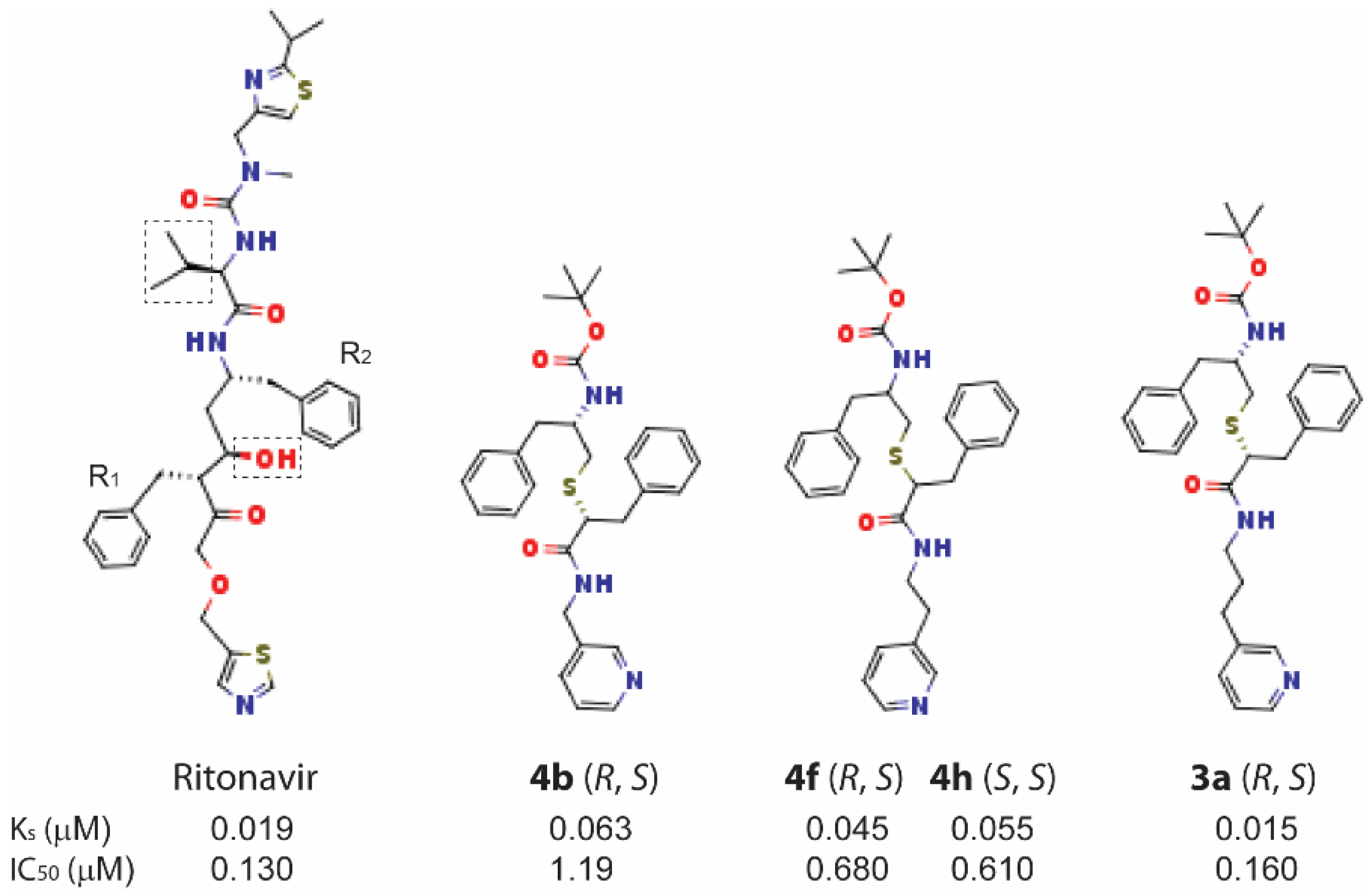

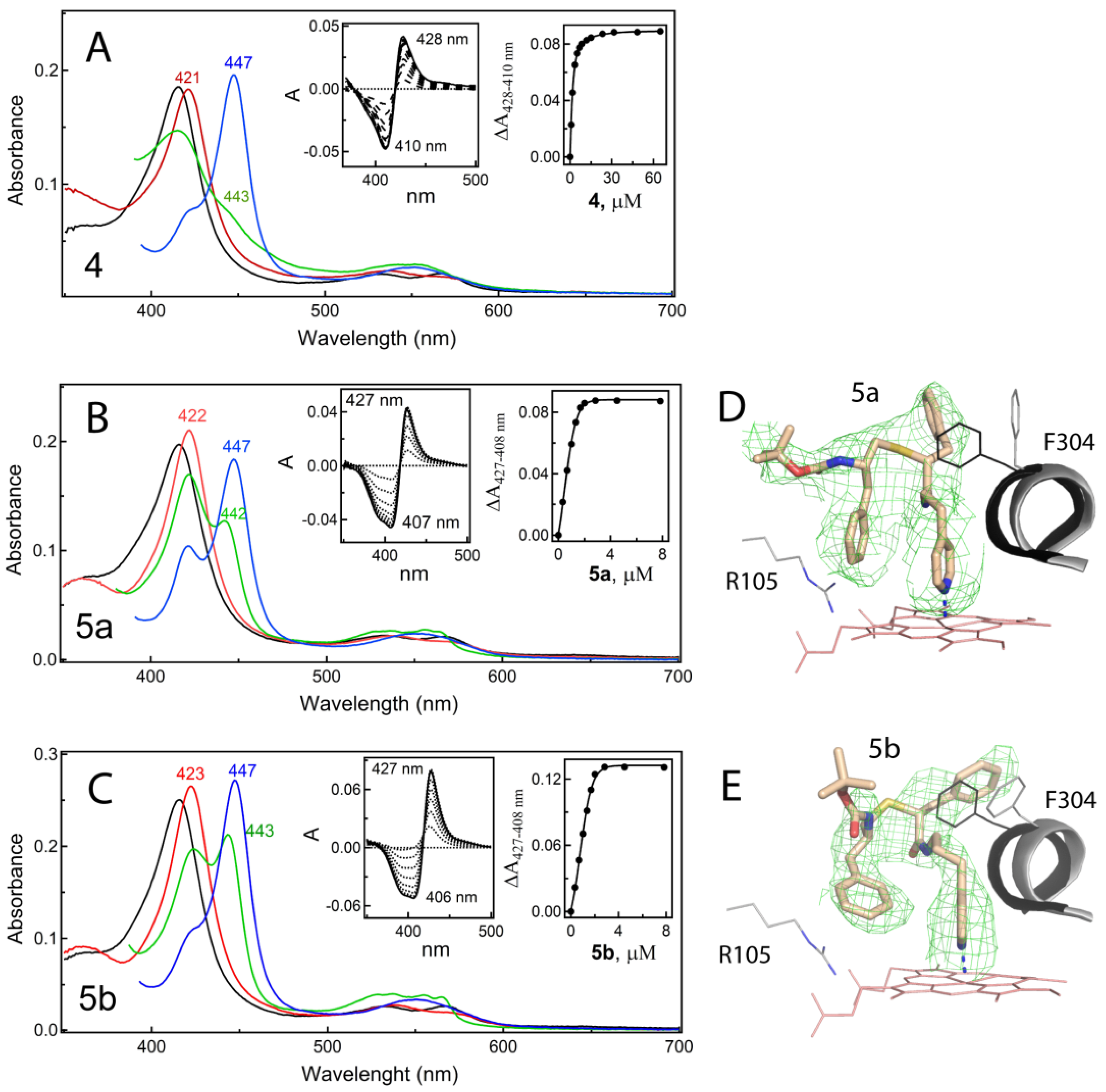
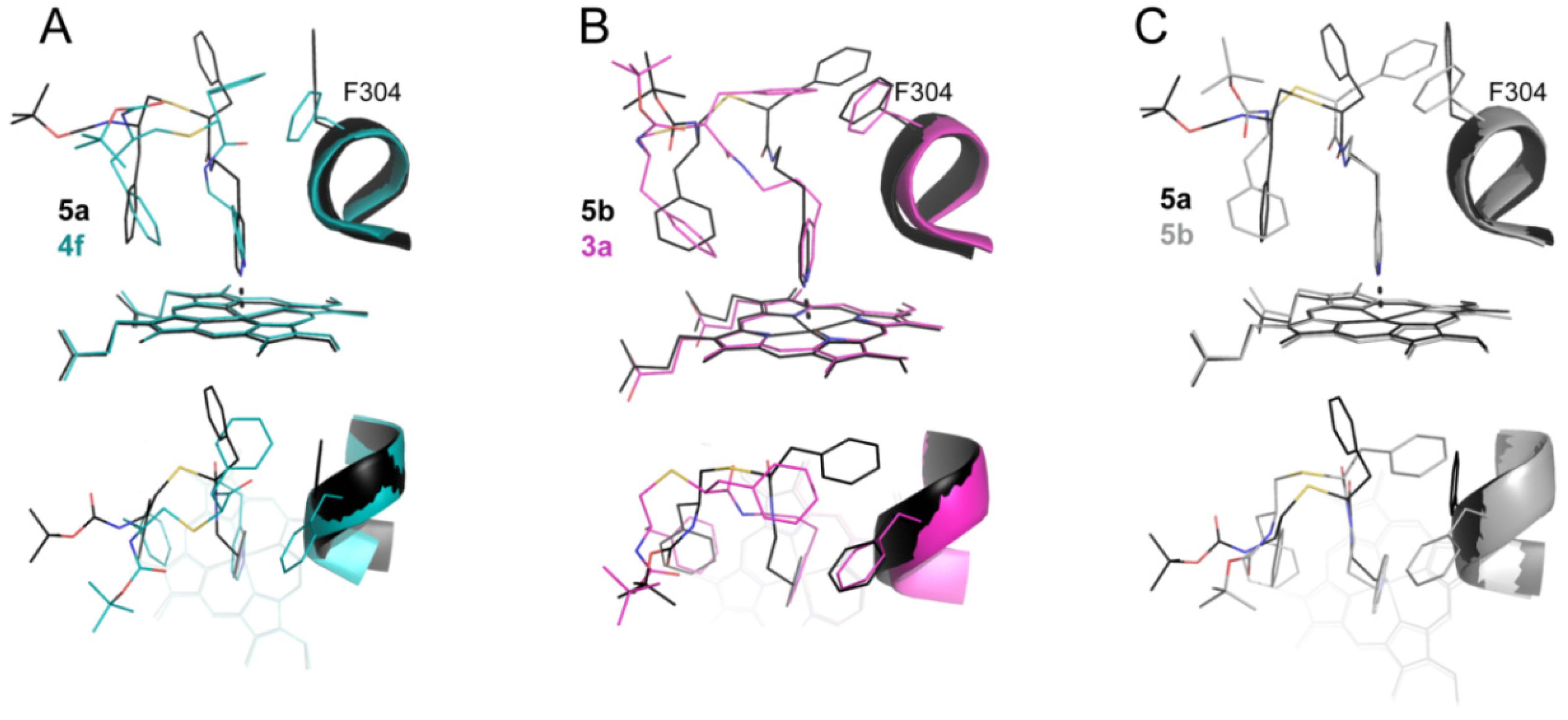
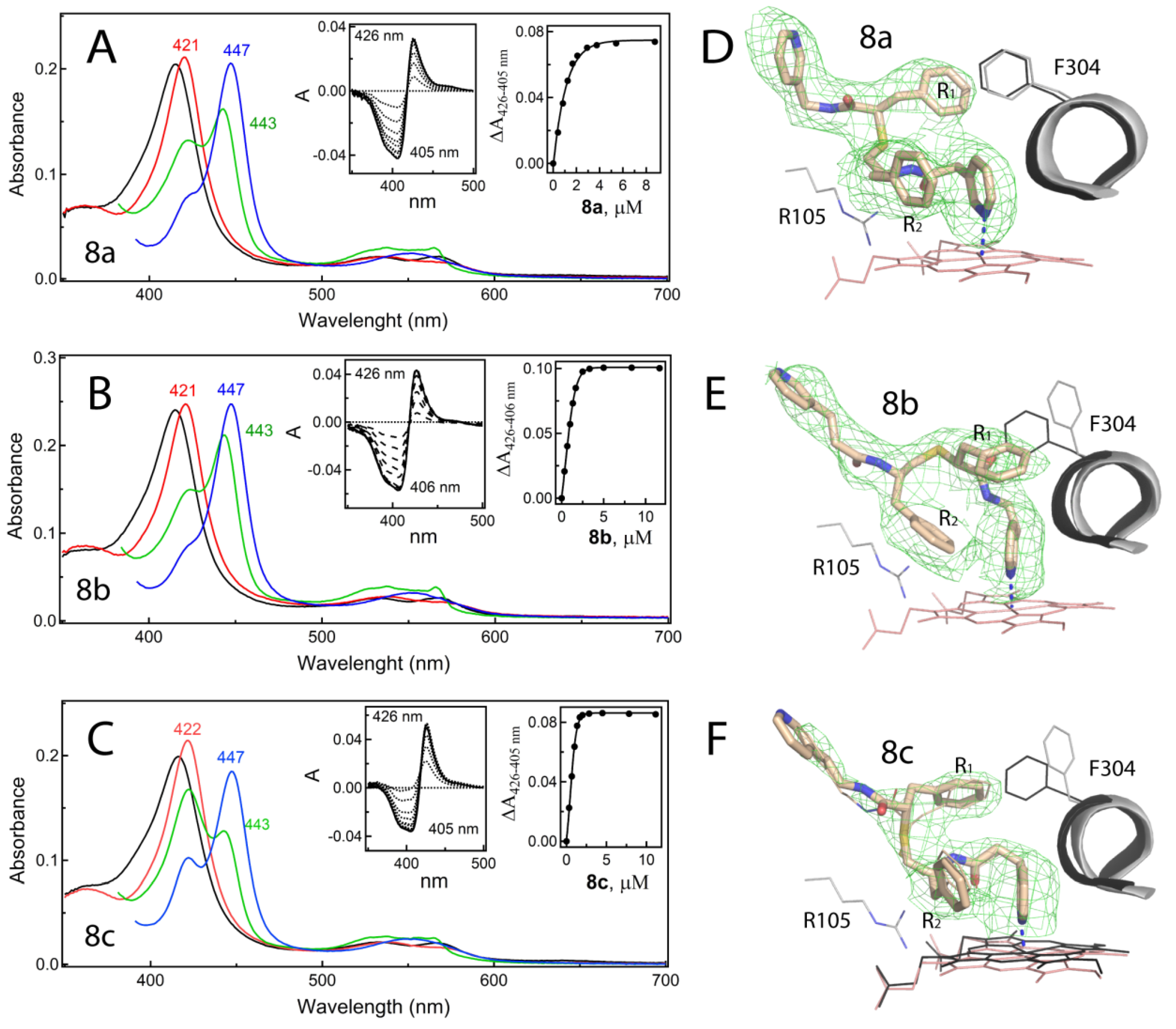
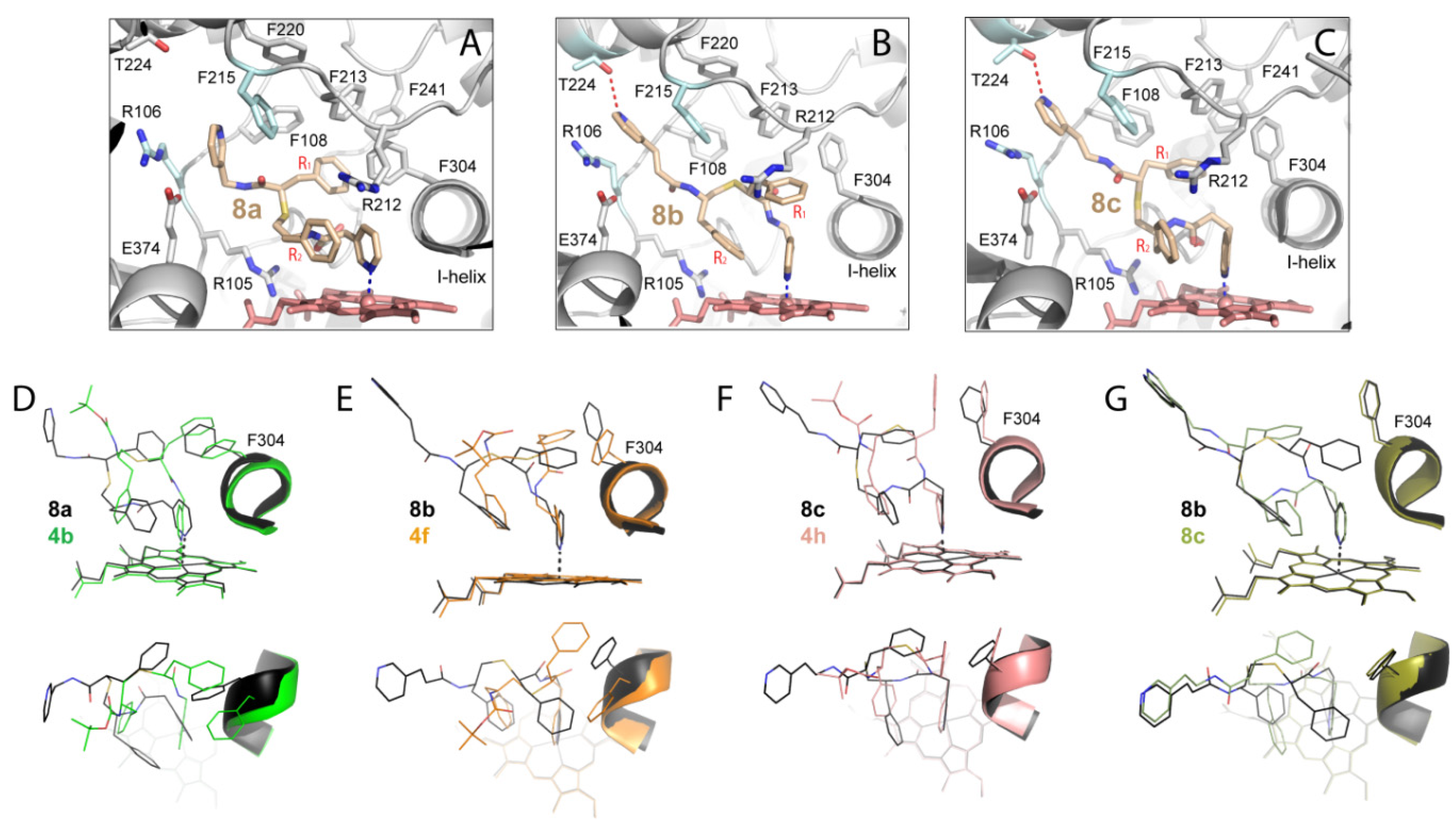
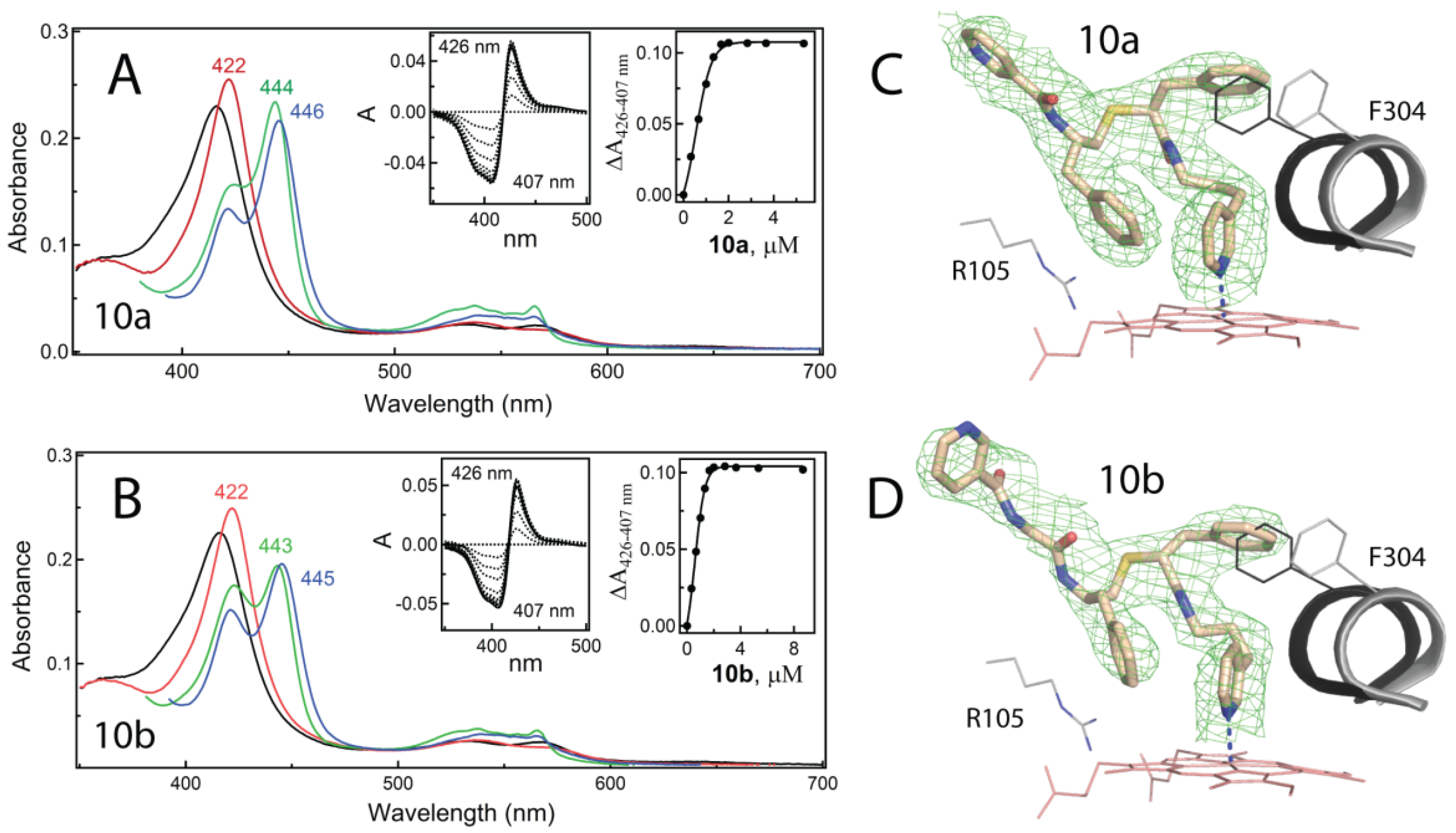




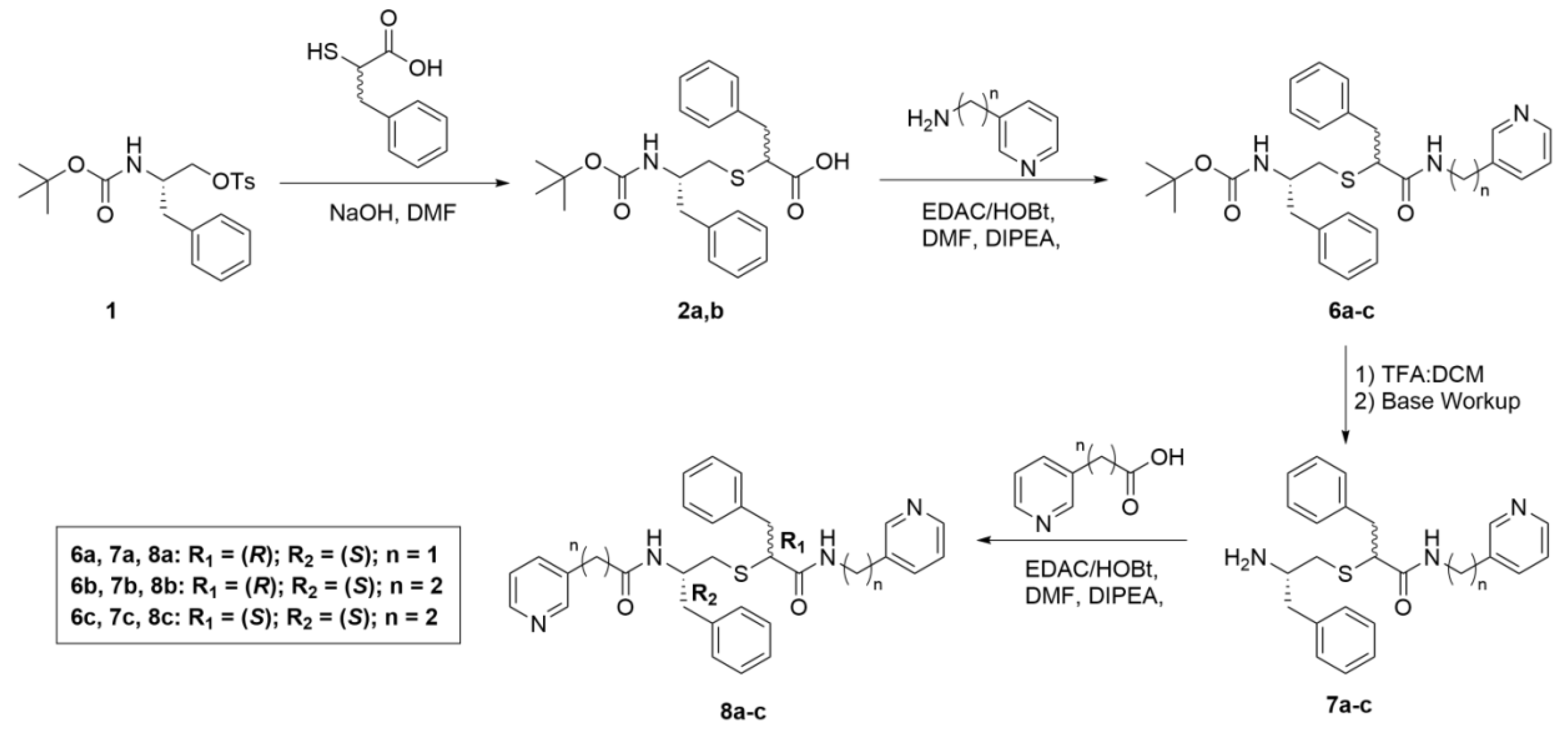

| Compound | λmax (nm) | A421/417 a | ΔAmax b | Ks c | IC50 d | IC50/Ks | ΔTm e |
|---|---|---|---|---|---|---|---|
| Ferric/Ferrous | % | μM | μM | °C | |||
| R1-meta-N-pyridine; R3-Boc | |||||||
| Pyridyl–peptidyl linker | |||||||
| 4 (R, S) | 421/- f | 0.99 | 98 | 1.36 ± 0.12 | 1.6 ± 0.2 | 1.2 | 1.9 |
| R1-para-N-pyridine; R3-Boc | |||||||
| Pyridyl–ethyl linker | |||||||
| 5a (R, S) | 422/443 | 1.07 | 105 | 0.034 ± 0.005 | 0.31 ± 0.03 | 9.1 | 5.2 |
| Pyridyl–propyl linker | |||||||
| 5b (R, S) | 423/443 | 1.06 | 126 | 0.014 ± 0.002 | 0.16 ± 0.02 | 11.4 | 5.0 |
| R1/R3-meta-N-pyridine | |||||||
| Pyridyl–methyl linker | |||||||
| 8a (R, S) | 421/443 | 1.03 | 96 | 0.120 ± 0.010 | 0.60 ± 0.04 | 5.0 | 3.6 |
| Pyridyl–ethyl linker | |||||||
| 8b (R, S) | 421/443 | 1.03 | 109 | 0.053 ± 0.009 | 0.82 ± 0.09 | 15.5 | 4.2 |
| 8c (S, S) | 422/443 | 1.08 | 103 | 0.015 ± 0.002 | 0.21 ± 0.03 | 14.0 | 4.5 |
| R1-meta-N-pyridine; pyridyl–propyl linker | |||||||
| R3-meta-N-pyridine; single amide bond linker | |||||||
| 10a (R, S) | 422/444 | 1.11 | 111 | 0.008 ± 0.001 | 0.15 ± 0.02 | 18.8 | 7.2 |
| R3-meta-N-pyridine; double amide bond linker | |||||||
| 10b (R, S) | 422/443 | 1.10 | 110 | 0.009 ± 0.001 | 0.21 ± 0.02 | 23.3 | 7.3 |
| kfast a | kH2O2 b | Heme Destroyed c | |
|---|---|---|---|
| Compound | s−1 | 103 × min−1 | (%) |
| 4 (R, S) | 13.8 ± 1.5 (27%) d | 0.70 ± 0.08 | 44 ± 5 |
| 5a (R, S) | 22.5 ± 3.1 (34%) | 0.31 ± 0.04 | 22 ± 3 |
| 5b (R, S) | 18.2 ± 1.8 (31%) | 0.31 ± 0.03 | 22 ± 2 |
| 8a (R, S) | 10.3 ± 1.2 (26%) | 0.66 ± 0.10 | 39 ± 4 |
| 8b (R, S) | 5.6 ± 0.6(24%) | 0.44 ± 0.06 | 32 ± 3 |
| 8c (S, S) | 15.0 ± 2.1 (28%) | 0.32 ± 0.03 | 24 ± 2 |
| 10a (R, S) | 15.4 ± 1.8 (30%) | 0.17 ± 0.02 | 13 ± 2 |
| 10b (R, S) | 13.7 ± 1.5 (29%) | 0.24 ± 0.03 | 19 ± 3 |
| Analogues from previous series | |||
| 4b (R, S) | 13.2 ± 1.8 (31%) | 0.64 ± 0.07 | 39 ± 5 |
| 4f (R, S) | 11.4 ± 1.4 (32%) | 0.60 ± 0.08 | 37 ± 4 |
| 4h (S, S) | 13.8 ± 2.0 (28%) | 0.32 ± 0.03 | 22 ± 3 |
| 3a (R, S) | 12.5 ± 1.3(36%) | 0.21 ± 0.03 | 18 ± 2 |
| Ritonavir | 7.5 ± 1.0 (27%) | 0.35 ± 0.05 | 26 ± 3 |
| Ligand-free | 4.2 ± 0.06 | 100 | |
| Compound | 5a | 5b | 8a | 8b | 8c | 10a | 10b |
|---|---|---|---|---|---|---|---|
| (R, S) | (R, S) | (R, S) | (R, S) | (R, S) | (R, S) | (R, S) | |
| Fe–N bond | |||||||
| distance (Å) | 2.06 | 2.08 | 2.29 | 2.10 | 2.04 | 2.16 | 2.21 |
| angle (°) a | 5 | 7 | 0 | 5 | 3 | 2 | 0 |
| Pyridine ring | 20 | 25 | 25 | 15 | 20 | 40 | 40 |
| rotation (°) b | |||||||
| I-helix dis- | |||||||
| placement (Å) c | 1.25–1.60 | 1.41–1.52 | 0.63–1.17 | 0.39–0.62 | 0.40–1.19 | 2.12–2.15 | 2.12–2.16 |
| H-bond (Å) | |||||||
| to Ser119 d | 2.96 | 2.55 | - | - | 2.61 | 2.76 | 2.46 |
| to Thr224 e | - | - | 3.29 | - | 2.93 | - | - |
| Pyridine–R2 ring angle; overlap | 5°; Half | 75°; Full | 25°; Full | 52°; Half | 35°; Half | 70°; Half | 55°; Half |
| Phe304–R1 ring angle; overlap | 25°; Partial | 55°; Half | 53°; Partial | 90°; None | 100°; Partial | 50°; Half | 55°; Half |
| S–π interaction f | − | − | − | − | − | + | + |
| End-group | 106–108 | 108,215 | 106–108 | 57, 76 | 57, 76 | 57, 106–108 | 53, 57, 76 |
| contacts | 374 | 482 | 215, 374 | 106–108, 215 | 107, 108 | 213, 224, 374 | 106–108 |
| 224 | 215, 374 | 213,215 | |||||
| 224, 372, 374 | |||||||
Publisher’s Note: MDPI stays neutral with regard to jurisdictional claims in published maps and institutional affiliations. |
© 2022 by the authors. Licensee MDPI, Basel, Switzerland. This article is an open access article distributed under the terms and conditions of the Creative Commons Attribution (CC BY) license (https://creativecommons.org/licenses/by/4.0/).
Share and Cite
Samuels, E.R.; Sevrioukova, I.F. Interaction of CYP3A4 with Rationally Designed Ritonavir Analogues: Impact of Steric Constraints Imposed on the Heme-Ligating Group and the End-Pyridine Attachment. Int. J. Mol. Sci. 2022, 23, 7291. https://doi.org/10.3390/ijms23137291
Samuels ER, Sevrioukova IF. Interaction of CYP3A4 with Rationally Designed Ritonavir Analogues: Impact of Steric Constraints Imposed on the Heme-Ligating Group and the End-Pyridine Attachment. International Journal of Molecular Sciences. 2022; 23(13):7291. https://doi.org/10.3390/ijms23137291
Chicago/Turabian StyleSamuels, Eric R., and Irina F. Sevrioukova. 2022. "Interaction of CYP3A4 with Rationally Designed Ritonavir Analogues: Impact of Steric Constraints Imposed on the Heme-Ligating Group and the End-Pyridine Attachment" International Journal of Molecular Sciences 23, no. 13: 7291. https://doi.org/10.3390/ijms23137291
APA StyleSamuels, E. R., & Sevrioukova, I. F. (2022). Interaction of CYP3A4 with Rationally Designed Ritonavir Analogues: Impact of Steric Constraints Imposed on the Heme-Ligating Group and the End-Pyridine Attachment. International Journal of Molecular Sciences, 23(13), 7291. https://doi.org/10.3390/ijms23137291






